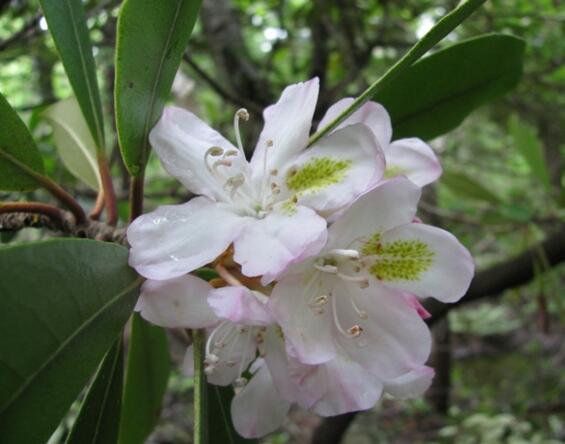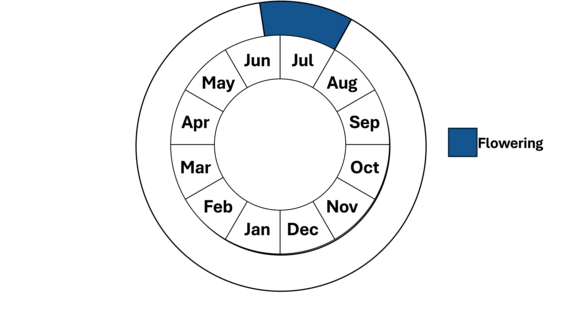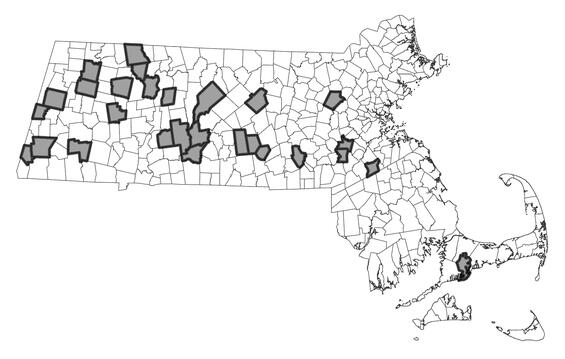- Scientific name: Rhododendron maximum L.
- Species of Greatest Conservation Need (MA State Wildlife Action Plan)
- Threatened (MA Endangered Species Act)
Description

Great Laurel in flower showing large evergreen leaves. Photo credit: Jennifer Garrett, NHESP
Great laurel, a member of the heath family (Ericaceae), is an evergreen shrub or small tree that grows up to 10 m (33 ft) high. Its 1-2 dm (3-8 in) long leaves are smooth-margined, alternate, leathery, and, usually, widest above the middle. In addition, the leaves are dark green above and paler green and pubescent (hairy) beneath. The leaves are at least 3 times longer than they are wide. The young branchlets are pubescent.. Great laurel's pink to white flowers are on sticky pedicels (flower stalks) and clustered in dome-shaped, terminal inflorescences. Each 3.5-4 cm (1.5 in) long flower is subtended by a short, five-lobed calyx (outermost floral whorl) and is spotted with yellow or orange on its inner surface. The fruit is a 10-15 mm (0.4-0.6 in) long, five-chambered, septicidal capsule (a dry fruit derived from a compound pistil that opens along the walls or "septa" dividing the various ovaries). Great laurel does best in filtered light and flowers from late June to late July. In winter, the flower buds of great laurel are often surrounded by short (< 2.5 cm [1 in.]) narrow bracts.
Similar species
Great laurel could be confused with mountain laurel (Kalmia latifolia). In contrast to great laurel, however, mountain laurel has flowers that are marked with purple. Furthermore, its hairless leaves are shorter, only 5-8 cm (2-3 in) compared to the 10-20 cm (4-8 in) of great laurel.
Life cycle and behavior
This is an evergreen species.

Population status
Great laurel is listed under the Massachusetts Endangered Species Act as threatened. All listed species are protected from killing, collecting, possessing, or sale and from activities that would destroy habitat and thus directly or indirectly cause mortality or disrupt critical behaviors. There are currently 33 occurrences of great laurel in Massachusetts verified since 1999, some of which consist of only a single plant. Occurrences have been verified extant in Barnstable, Berkshire, Franklin, Hampden, Hampshire, Middlesex, Norfolk and Worcester Counties. Nine populations have sufficient plants for long-term viability.
Distribution and abundance
Great laurel has been observed from Nova Scotia south to Georgia, and as far west as Ohio, Kentucky, Tennessee and Alabama. It is rare in the northeast, with it being presumed extirpated from Nova Scotia, critically imperiled in Maine, imperiled in Massachusetts, New Hampshire and Vermont, vulnerable in Connecticut, and unranked in Rhode Island. It is considered secure in most of the rest of its range, except vulnerable in Ohio.

Distribution in Massachusetts
1999-2024
Based on records in the Natural Heritage Database
Habitat
Great laurel is a plant of moist woods, swamps, and the edges of ponds. Its habitats in Massachusetts include the edge of a boggy swamp; an Atlantic white cedar swamp, near an open pond; a forested seepage fen (a peat-forming area where very cold, nutrient-poor water seeps to the surface); and the edge of a red maple swamp. Among the plant species associated with great laurel are red maple (Acer rubrum), hemlock (Tsuga canadensis), red oak (Quercus rubra), yellow birch (Betula alleghaniensis), white pine (Pinus strobus), mountain laurel (Kalmia latifolia), highbush blueberry (Vaccinium corymbosum), winterberry (Ilex verticillata), spicebush (Lindera benzoin), skunk cabbage (Symplocarpus foetidus), and interrupted, cinnamon and royal ferns (Osmunda claytoniana, O. cinnamomea and O. regalis). Associated, uncommon Massachusetts plants include swamp red currant (Ribes triste).
Healthy habitats are vital for supporting native wildlife and plants. Explore habitats and learn about conservation and restoration in Massachusetts.
Threats
As deer populations have increased across the state, they have become a major threat to great laurel. Larger populations now have browse lines in the lower parts and seedlings are quickly browsed to nothing. At several great laurel sites, non-native invasive species including glossy buckthorn (Frangula alnus) are present. Sites should be monitored for invasions of exotic plants; if exotic plants are crowding and outcompeting this species, a plan should be developed, in consultation with MassWildlife’s Natural Heritage & Endangered Species Program (NHESP), to remove the invaders. Other threats include, especially in the past, collecting for home landscaping. The prohibition of take under the Massachusetts Endangered Species Act currently limits collection.
Conservation
In cases where dense overstory has grown and appears to be causing declines in the population, management to open the canopy to prevent shading of concentrated populations may be considered again, a plan should be developed in consultation with NHESP. All active management of rare plant populations (including invasive species removal) is subject to review under the Massachusetts Endangered Species Act and should be planned in close consultation with the NHESP.
References
Gleason, Henry A., and Arthur Cronquist. Manual of Vascular Plants of Northeastern United States and Adjacent Canada, Second Edition. Bronx, NY: The New York Botanical Garden, 1991.
Haines, A. 2011. Flora Novae Angliae – a Manual for the Identification of Native and Naturalized Higher Vascular Plants of New England. New England Wildflower Society, Yale Univ. Press, New Haven, CT.
NatureServe. 2025. NatureServe Network Biodiversity Location Data accessed through NatureServe Explorer [web application]. NatureServe, Arlington, Virginia. Available https://explorer.natureserve.org/. Accessed: 5/27/2025.
POWO (2025). Plants of the World Online. Facilitated by the Royal Botanic Gardens, Kew. Published on the Internet; https://powo.science.kew.org/ Accessed: 5/27/2025.
Contact
| Date published: | May 6, 2025 |
|---|